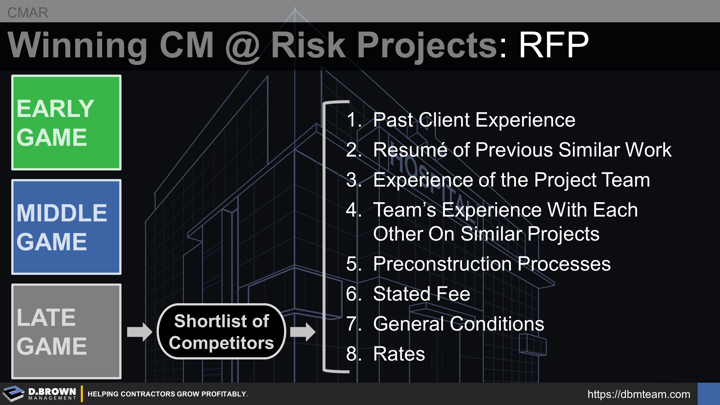Your strategic market choices and business development have allowed you to win at the Early and Middle Game. The opportunity has made it through your rigorous opportunity evaluation process and aligns well both strategically and operationally. You have the RFP (Request for Proposal) and your objective is to get to the interview.
All project owners will have their own scoring -- including weighting. Some of them make this very public while it is more obscure for others. There are eight major factors that regularly come into play when project owners are evaluating RFPs. Always prepare your team and your RFP response around these.
- Past client experience. All other things being equal, they will focus on who they have successfully worked with in the past. If you are an incumbent contractor, you want this factor weighted as highly as possible. If you are trying to break into a new customer, you will have to rely on all other factors and lobby to get the weighting on this lowered.
- Resumé of previous similar work experience - critical to have a database of this built so it is easy to pull from. Often projects can be categorized in multiple ways. You don't want to have to recreate this from scratch for each proposal. Make sure to include those that are most relevant and tailor descriptions to most resonate with the intent of this RFP.
- Experience of the project team - what is their individual knowledge?
- Team's experience with each other on similar projects. Individual experience matters but it is how effectively the overall team works together that delivers projects.
- Preconstruction processes - how specifically will you meet the intent of the programming (Conditions of Satisfaction - CoS) while helping the team navigate through Design Development and Construction Document stages through to selecting specialty contractors. See comparison of CMAR vs. DBB.
- Stated fee - what your base fee will be. This may be a simple percentage or a combination of several things including a cap.
- General conditions
- Rates
Remember that fees, general conditions, and rates are the easiest to quantify but are not typically the biggest drivers in successful project delivery. It all starts in preconstruction and adding value from the perspective of the project owner. You must ensure the project starts with a constructible design that can meet budget and schedule requirements. From there it is all about project delivery.


